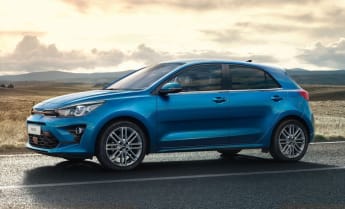Australia is experiencing a mass extinction event.
Like the dinosaurs before them, and hopefully not the bees in the near future, the sub-$20,000 car is nearing the bitter end.
An evolutionary dead-end, as higher emissions and safety regulations relegate older models (read Mitsubishi Mirage) to the great scrap-heap in the sky and prevent newer ones (read Honda Jazz) from leaving their local markets.
For you, this means there are quite literally a handful of brand-new vehicles left in Australia which wear before-on-road price-tags under the magic $20,000 number.
One of them is the car we’re looking at for this review: The Kia Rio S, with the catch being you’ll have to be happy changing gears yourself.
So, is this most basic Rio worth your while, or is it best left as a puzzling fossil for future generations to study? Let’s have a look.
Kia RIO 2022: S
| Engine Type | Inline 4, 1.4L |
|---|---|
| Fuel Type | Unleaded Petrol |
| Fuel Efficiency | 6.0L/100km (combined) |
| Seating | 5 |
| Price From | $16,500 - $21,120 |
| Safety Rating |
|
Does it represent good value for the price? What features does it come with?
Value seems less important here when you’re contending with a limited list of potential options at this end of the market.
The Rio S manual currently wears an MSRP of $19,690, and if you’re able to shuffle cogs yourself, it counts its rivals as the Suzuki Baleno GL ($18,490), Suzuki Ignis GL ($19,490), or Fiat 500 Lounge ($19,550).
There’s also the option of the MG3 (from $18,990) or Kia’s own much smaller Picanto (from $15,990).
I’m pleased to report the Rio S is one of the best among these options, though. Not only is this car much more modern in terms of its platform and design than pretty much anything on that list, it packs great standard equipment, too.
The major wow-factor item is the Rio’s best-in-class multimedia system, consisting of an 8.0-inch touchscreen with wireless Apple CarPlay and Android Auto connectivity, just one of the areas where this car will grab eyes over rivals.
.jpg)
Elsewhere is a predictably honest list of standard equipment, including basic halogen headlights, 15-inch steel wheels, manual air conditioning, cloth seat trim with a polyurethane steering wheel, a small multifunction display in the dash, two USB ports, a six-speaker audio system, and surprisingly, steering-wheel mounted controls.
.jpg)
There’s no keyless entry or push-start ignition, and this level of equipment makes you feel lucky to have automatic headlights. Sadly, the S manual also misses out on the basic luxury of cruise control.
It’s cheap, missing a lot of gear, and feels it with an abundance of plastic trims, but somehow this car gets by with almost everything you really, truly need. Sure, it’s a bit of a hark back to the equipment lists of the early 2000s, but if you’re just looking for a basic car to get the job done, you could do far worse than this Kia with its impressive multimedia offering.
Is there anything interesting about its design?
While notable equipment is missing, the Rio reclaims lost ground with the way it looks, and to a degree, the way it feels.
Ever since this new generation hatch launched, I’ve thought it brings a slick modern design to the city-car space, and even in its most rudimentary form as-tested (our car even came in the most basic ‘Clear White’ paint) it’s a great looking little hatch.
Sure, it doesn’t have the romance factor of the Fiat 500, nor the more delicate curvature of the much more expensive new-generation Toyota Yaris, but it certainly has a more refined visage than, say, the MG3 whilst feeling a bit more grown-up than the Suzuki Swift.
Solid, squared-off lines give this car a sporty pose, and its frowny-face and blocky rear round out a stout city-car persona, and I especially like the way even this most basic trim is adorned with contrast pieces, a spoiler above the boot lid, and body-coloured door handles and mirrors.
.jpg)
Sure, the 15-inch steelies dress it down a bit, but on the Rio these leave the impression of financial prudence rather than cost-cutting.
Inside is basic but tidy. The overall look maintains a hint of sportiness, with an appealing symmetrical finish to the dash.
.jpg)
There’s no question the Rio is a budget model when it comes to the touch though, with everything either a soft polyurethane or a nasty hard plastic, so while it all might look neat it’s far from the most comfortable place to be for long periods of time.
The basic dot-matrix multifunction display, chunky plastic air-conditioning controls, and polyurethane items from the wheel to the handbrake and shifter are reminders of a bygone era, but the overall aesthetic of the driver’s space is pleasing.
How practical is the space inside?
I'd argue the key reason to buy the Rio at this end of the market is that it has the most space and largest cabin relative to its rivals, bar maybe the Suzuki Baleno.
All-round practicality is great, with front passengers scoring a low, sporty seating position with a high roof, and so much width in the cabin it almost feels like the Rio belongs in the next segment up.
Storage options up front include a large bottle holder and bin in each of the doors, dual cupholders next to the handbrake up front, and a large storage tray underneath the climate unit. Unlike the Yaris or Mazda2, the Rio features a small armrest console box, which gives a small lift to the ambiance of the cabin.
Back seat passengers are treated to great space for this segment, which feels nice and open courtesy of the large rear windows. At 182cm tall, I have airspace for my knees behind my own driving position, as well as relatively healthy headroom and ample width, which is again more like a car in the next segment up.
.jpg)
Rear passengers don’t get adjustable air vents, but there is a single USB port, a single pocket on the back of the passenger seat, and small bottle holders in each of the doors.
Perhaps the Rio’s biggest drawcard is its boot capacity, which at 325 litres is one of the largest in the city car class. Unlike the Yaris, Mazda2, or Suzuki Swift, the Rio will actually accept the CarsGuide three-piece luggage set with the rear seats up, although the rear view was obscured by the medium case.
Thanks to the boxy roofline, the Rio offers a cavernous 980L with the rear seats folded down, and despite its abundance of room, maintains a space saver spare wheel under the floor.
What are the key stats for the engine and transmission?
The Rio is beginning to fall behind here with an antiquated 1.4-litre four-cylinder non-turbo petrol engine. Peak outputs aren’t far off where they should be for this segment, with 74kW of power and 133Nm of torque, although they arrive at the most distant end of the rpm range (6000rpm and 4000rpm respectively) so you need to rev it.
.jpg)
It can be clumsy to extract this power, too, with the engine paired in this circumstance to a six-speed manual which leaves a lot to be desired in terms of action and clutch feel.
While the abundance of ratios can be beneficial for fuel consumption, it’s clear this car was designed to be paired with the more modern three-cylinder turbocharged engine only available on the top GT-Line trim.
How much fuel does it consume?
The Rio S manual has an official combined cycle fuel consumption rating of 5.6L/100km, which is about right for a light car with a small engine.
On test, covering largely urban kilometres, I saw a higher but not unreasonable 7.4L/100km. Still, this number isn’t too far off what some larger cars with 2.0-litre engines are capable of.
Rios with this engine accept entry-level 91RON unleaded fuel, and have 45-litre fuel tanks. They are only compliant with Euro 5 emissions regulations.
Warranty & Safety Rating
What safety equipment is fitted? What safety rating?
Sadly, the Rio S misses out on any advanced active safety items. This is one area where city-sized cars are struggling to keep up, as expensive active safety systems tend to push them well into the mid-$20,000 region.
Unlike the mid-range Rio Sport, the S has no auto emergency braking, lane keep assist, or driver attention alert.
It makes do with the more basic array of brake, stability and traction controls, with the addition of a great reversing camera, three top-tether and two ISOFIX child seat mounting points, and six airbags.
The Rio carries a valid five-star ANCAP safety rating, to an earlier 2017 standard before its missing modern active safety items were mandated.
What does it cost to own? What warranty is offered?
The Rio again gets the edge on its budget competition with a lengthy seven-year, unlimited kilometre warranty. In this space it only butts heads with the MG3, which offers a matching promise.
.jpg)
Roadside assist is included for up to eight years if you continue to service with Kia, and there's also a capped price service program for the duration of the warranty, covering up to 105,000km.
The Rio needs to be serviced once every 12 months or 15,000km, and prices range from $269 and $608 per visit, for an annual average of $409.40.
Not the cheapest servicing schedule we’ve seen, particularly when compared with the likes of Toyota.
What's it like to drive around town?
A six-speed manual with a tiny non-turbo engine is an absolute oddity in today’s new car market, but as a result of its rudimentary approach, there’s something refreshingly honest about the Rio S.
The engine requires a wringing to extract the desired result, and a lot of action on the gears, as six speeds proves to be quite a few to work your way through before you achieve cruising speed.
As so much interaction is required with the transmission, I wish it was tighter when it comes to the clutch which feels a bit doughy at the best of times.
The Rio is very organic, though, with next to no electrical assistance for any of its interaction points offering the driver a high level of control.
The steering is direct, but as a result of a cheaper rack (with less teeth compared to this car’s Stonic relation), it feels simple and brittle when it comes to feedback.
The same criticism can be levelled at the suspension, which errs on the side of firm. This attribute combines with the low seating position to make even this most basic Rio an absolute hoot in the corners.
But it can be a little crashy over every-day potholes and corrugations, despite the abundant amount of rubber cladding the 15-inch steel wheels.
Visibility is superb out of this little car’s big windows, making you feel in control of your surroundings (necessary in the multi-lane confines and tight parking conditions of a city), and ergonomics in the cabin are absolutely on-point with the large touchscreen elements easy to reach and the instruments taking a basic no-nonsense form.
While noise levels are okay at urban speeds, they pick up above 80km/h, making the Rio more unpleasant to drive over long distances than, say, the more upmarket-feeling Yaris.
The Rio does find its place in this price bracket as a fun-to-drive, but predictably rudimentary experience, for the niche audience of drivers seeking an entry-level car who are still able to shift gears themselves.
Verdict
The Rio S Manual is a fun-to-drive little car with a big practicality and multimedia offering in a segment rapidly heading towards extinction.
While some elements of the drive experience are reminiscent of budget cars from 10-20 years ago, Kia makes up for it by wrapping the Rio in a contemporary looking and feeling package, ready for the buyer who needs no frills and demands no nonsense. Until the manual transmission goes the way of the dodo, there is almost no better option.
Pricing Guides




.jpg)

.jpg)
.jpg)
.jpg)
.jpg)
.jpg)
.jpg)
.jpg)
.jpg)

.jpg)
.jpg)
.jpg)
.jpg)
.jpg)
.jpg)
.jpg)
.jpg)
.jpg)
.jpg)
.jpg)
.jpg)








































.jpeg)

.jpg)
.jpg)


.jpg)

.jpg)
Comments